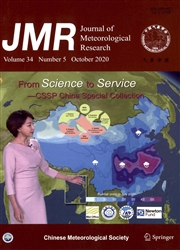Hailstorm Formation Enhanced by Meso-γ Vortices along a Low-Level Convergence Line
作者:Honglei ZHANG,Hangfeng SHEN,Guoqing ZHAI
摘要:During a hailstorm event,near-surface meso-γvortices along a convergence line interact with hail cells.Herein we investigate this interaction by using observational data and a high-resolution simulation of a hailstorm that occurred over Taizhou(Zhejiang,China)on 19 March 2014.The 10-m surface wind data from automatic weather stations show that several meso-γvortices or vortex-like disturbances existed over the convergence zone and played a vital role in the evolution of the hailstorm and the location of the hail.The model results agree with the observations and present a closer correlation between the hail and the low-level meso-γvortices than those observed.The model simulation indicates that such low-level meso-γvortices can be used to predict the next 10-min hail fallout zone.The lowlevel meso-γvortices originated over the convergence zone and then fed back into the convergence field and provoked a stronger updraft.Vorticity was initiated primarily by stretching and was extended by tilting.A three-dimensional(3-D)flow analysis shows that the existence of low-level meso-γvortices could help enhance a local updraft.Furthermore,the simulation reveals that the low-level meso-γvortices formed in the bounded weak echo region(WER)at the front of the hail cell,enhancing convergence and strengthening updrafts.Graupel was broadly located between the 0°C isothermal line and the top of the clouds,roughly between the 0 and-20°C isothermal lines.Accordingly,the hailstones grew rapidly.The suitable environment and the positive effect of the meso-γvortices on the updrafts enabled hailstorm formation.
发文机构:Zhejiang Institute of Meteorological Sciences Department of Atmospheric Sciences Hangzhou Weather Bureau
关键词:HAILSTORMmeso-γvorticesspecialterrainhigh-resolutionsimulationstrongupdraft
分类号: O17[理学—基础数学]
- Major Scientific Achievements of the First China–Japan Cooperative GAME/HUBEX Experiment: A Historical Review
- Identifying and Quantifying Pixel-Level Uncertainty among Major Satellite Derived Global Land Cover Products
- A Multivariable Approach for Estimating Soil Moisture from Microwave Radiation Imager(MWRI)
- Spatial Distribution and Temporal Trend Characteristics of Agro-Climatic Resources and Extreme Climate Events during the Soybean Growing Season in Northeast China from 1981 to 2017
- Bias Analysis and Correction of Ground Surface Temperature Observations across China
- Research Progress on Estimation of the Atmospheric Boundary Layer Height
- Joint Effect of East Asia-Pacific and Eurasian Teleconnections on the Summer Precipitation in North Asia
- Increasing Trend of Summertime Synoptic Wave Train Activity over the Western North Pacific since 1950
- Spatiotemporal Drought Assessment over Sahelian Countries from 1985 to 2015
- Climate Sensitivity and Feedbacks of BCC-CSM to Idealized CO2 Forcing from CMIP5 to CMIP6


